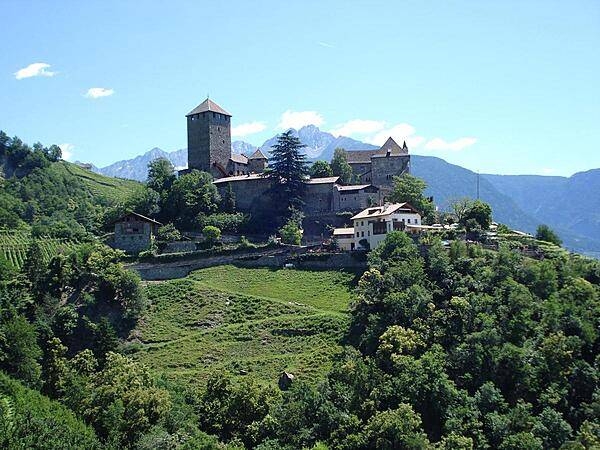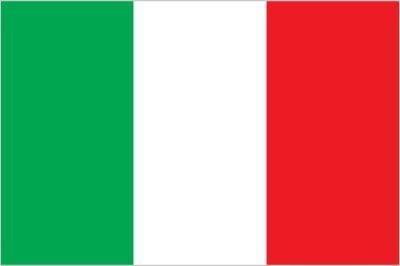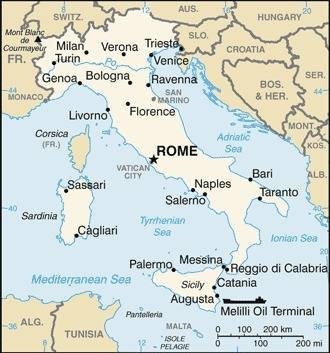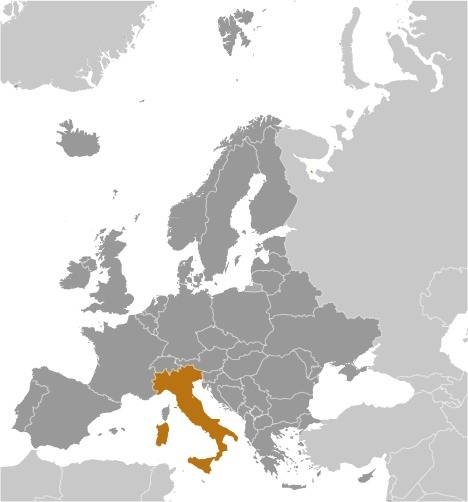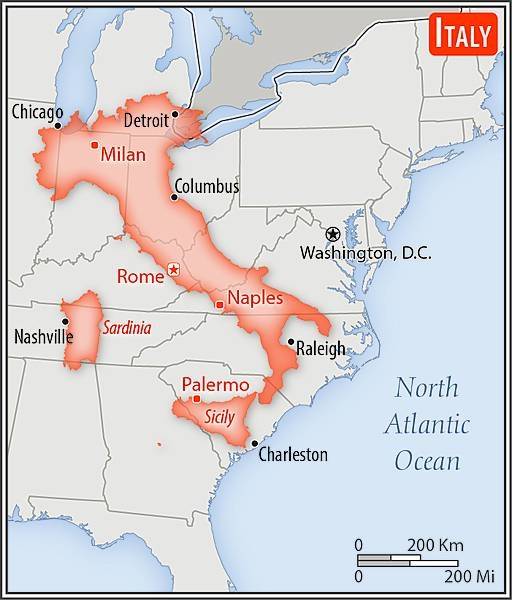Introduction
Background
Italy became a nation-state in 1861 when the regional states of the peninsula, along with Sardinia and Sicily, were united under King Victor EMMANUEL II. An era of parliamentary government came to a close in the early 1920s when Benito MUSSOLINI established a Fascist dictatorship. His alliance with Nazi Germany led to Italy's defeat in World War II. A democratic republic replaced the monarchy in 1946 and economic revival followed. Italy is a charter member of NATO and the European Economic Community (EEC) and its subsequent successors the EC and the EU. It has been at the forefront of European economic and political unification, joining the Economic and Monetary Union in 1999. Persistent problems include sluggish economic growth, high youth and female unemployment, organized crime, corruption, and economic disparities between southern Italy and the more prosperous north.
Visit the Definitions and Notes page to view a description of each topic.
Geography
Location
Southern Europe, a peninsula extending into the central Mediterranean Sea, northeast of Tunisia
Geographic coordinates
42 50 N, 12 50 E
Map references
Europe
Area
total: 301,340 sq km
land: 294,140 sq km
water: 7,200 sq km
note: includes Sardinia and Sicily
Land boundaries
total: 1,836.4 km
border countries (6): Austria 404 km; France 476 km; Holy See (Vatican City) 3.4 km; San Marino 37 km; Slovenia 218 km; Switzerland 698 km
Coastline
7,600 km
Maritime claims
territorial sea: 12 nm
continental shelf: 200-m depth or to the depth of exploitation
Climate
predominantly Mediterranean; alpine in far north; hot, dry in south
Terrain
mostly rugged and mountainous; some plains, coastal lowlands
Elevation
highest point: Mont Blanc (Monte Bianco) de Courmayeur (a secondary peak of Mont Blanc) 4,748 m
lowest point: Mediterranean Sea 0 m
mean elevation: 538 m
Natural resources
coal, antimony, mercury, zinc, potash, marble, barite, asbestos, pumice, fluorspar, feldspar, pyrite (sulfur), natural gas and crude oil reserves, fish, arable land
Land use
agricultural land: 47.1% (2018 est.)
arable land: 22.8% (2018 est.)
permanent crops: 8.6% (2018 est.)
permanent pasture: 15.7% (2018 est.)
forest: 31.4% (2018 est.)
other: 21.5% (2018 est.)
Irrigated land
26,010 sq km (2013)
Major watersheds (area sq km)
Atlantic Ocean drainage: Rhine-Maas (198,735 sq km), (Black Sea) Danube (795,656 sq km), (Adriatic Sea) Po (76,997 sq km), (Mediterranean Sea) Rhone (100,543 sq km)
Population distribution
despite a distinctive pattern with an industrial north and an agrarian south, a fairly even population distribution exists throughout most of the country, with coastal areas, the Po River Valley, and urban centers (particularly Milan, Rome, and Naples), attracting larger and denser populations
Natural hazards
regional risks include landslides, mudflows, avalanches, earthquakes, volcanic eruptions, flooding; land subsidence in Venice
volcanism: significant volcanic activity; Etna (3,330 m), which is in eruption as of 2010, is Europe's most active volcano; flank eruptions pose a threat to nearby Sicilian villages; Etna, along with the famous Vesuvius, which remains a threat to the millions of nearby residents in the Bay of Naples area, have both been deemed Decade Volcanoes by the International Association of Volcanology and Chemistry of the Earth's Interior, worthy of study due to their explosive history and close proximity to human populations; Stromboli, on its namesake island, has also been continuously active with moderate volcanic activity; other historically active volcanoes include Campi Flegrei, Ischia, Larderello, Pantelleria, Vulcano, and Vulsini
Geography - note
strategic location dominating central Mediterranean as well as southern sea and air approaches to Western Europe
People and Society
Nationality
noun: Italian(s)
adjective: Italian
Ethnic groups
Italian (includes small clusters of German-, French-, and Slovene-Italians in the north and Albanian-Italians and Greek-Italians in the south)
Languages
Italian (official), German (parts of Trentino-Alto Adige region are predominantly German-speaking), French (small French-speaking minority in Valle d'Aosta region), Slovene (Slovene-speaking minority in the Trieste-Gorizia area)
major-language sample(s):
L'Almanacco dei fatti del mondo, l'indispensabile fonte per le informazioni di base. (Italian)
The World Factbook, the indispensable source for basic information.
Religions
Christian 80.8% (overwhelmingly Roman Catholic with very small groups of Jehovah's Witnesses and Protestants), Muslim 4.9%, unaffiliated 13.4%, other 0.9% (2020 est.)
Age structure
0-14 years: 13.45% (male 4,292,431/female 4,097,732)
15-24 years: 9.61% (male 3,005,402/female 2,989,764)
25-54 years: 40.86% (male 12,577,764/female 12,921,614)
55-64 years: 14% (male 4,243,735/female 4,493,581)
65 years and over: 22.08% (male 5,949,560/female 7,831,076) (2020 est.)
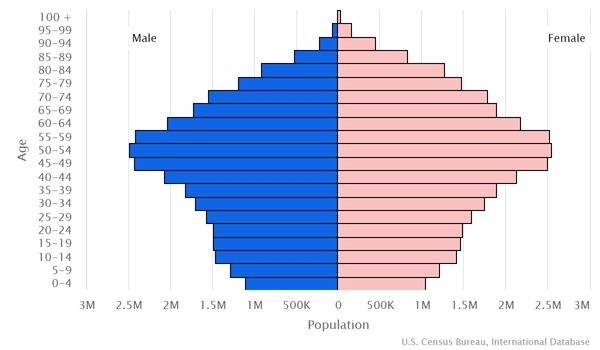
Dependency ratios
total dependency ratio: 57.1
youth dependency ratio: 19.9
elderly dependency ratio: 37.2
potential support ratio: 2.7 (2021 est.)
Median age
total: 46.5 years
male: 45.4 years
female: 47.5 years (2020 est.)
Population distribution
despite a distinctive pattern with an industrial north and an agrarian south, a fairly even population distribution exists throughout most of the country, with coastal areas, the Po River Valley, and urban centers (particularly Milan, Rome, and Naples), attracting larger and denser populations
Urbanization
urban population: 72% of total population (2023)
rate of urbanization: 0.27% annual rate of change (2020-25 est.)
Major urban areas - population
4.316 million ROME (capital), 3.155 million Milan, 2.179 million Naples, 1.802 million Turin, 913,000 Bergamo, 850,000 Palermo (2023)
Sex ratio
at birth: 1.06 male(s)/female
0-14 years: 1.05 male(s)/female
15-24 years: 1.01 male(s)/female
25-54 years: 0.97 male(s)/female
55-64 years: 0.95 male(s)/female
65 years and over: 0.67 male(s)/female
total population: 0.93 male(s)/female (2022 est.)
Mother's mean age at first birth
31.4 years (2020 est.)
Maternal mortality ratio
2 deaths/100,000 live births (2017 est.)
country comparison to the world: 182Infant mortality rate
total: 3.16 deaths/1,000 live births
male: 3.32 deaths/1,000 live births
female: 2.99 deaths/1,000 live births (2022 est.)
Life expectancy at birth
total population: 82.59 years
male: 80.25 years
female: 85.08 years (2022 est.)
Contraceptive prevalence rate
65.1% (2013)
note: percent of women aged 18-49
Drinking water source
improved: urban: NA
rural: NA
total: 99.9% of population
unimproved: urban: NA
rural: NA
total: 0.1% of population (2020 est.)
Current health expenditure
8.7% of GDP (2019)
Physicians density
3.95 physicians/1,000 population (2020)
Hospital bed density
3.1 beds/1,000 population (2018)
Sanitation facility access
improved: urban: 100% of population
rural: 100% of population
total: 100% of population
unimproved: urban: 0% of population
rural: 0% of population
total: 0% of population (2020 est.)
Major infectious diseases
note: a new coronavirus is causing respiratory illness (COVID-19) in Italy; illness with this virus has ranged from mild to severe with fatalities reported; as of 9 December 2022, Italy has reported a total of 24,488,080 cases of COVID-19 or 41,058.8 cumulative cases of COVID-19 per 100,000 population with a total of 181,733 cumulative deaths or a rate of 304.7 cumulative deaths per 100,000 population; as of 8 December 2022, 86.15% of the population has received at least one dose of COVID-19 vaccine; the US Department of Homeland Security has issued instructions requiring US passengers who have been in Italy to travel through select airports where the US Government has implemented enhanced screening procedures
Alcohol consumption per capita
total: 7.65 liters of pure alcohol (2019 est.)
beer: 1.99 liters of pure alcohol (2019 est.)
wine: 4.83 liters of pure alcohol (2019 est.)
spirits: 0.83 liters of pure alcohol (2019 est.)
other alcohols: 0 liters of pure alcohol (2019 est.)
Tobacco use
total: 23.1% (2020 est.)
male: 26.6% (2020 est.)
female: 19.5% (2020 est.)
Literacy
definition: age 15 and over can read and write
total population: 99.2%
male: 99.4%
female: 99% (2018)
School life expectancy (primary to tertiary education)
total: 16 years
male: 16 years
female: 17 years (2020)
Youth unemployment rate (ages 15-24)
total: 29.7%
male: 27.7%
female: 32.8% (2021 est.)
Environment
Environment - current issues
air pollution from industrial emissions such as sulfur dioxide; coastal and inland rivers polluted from industrial and agricultural effluents; acid rain damaging lakes; inadequate industrial waste treatment and disposal facilities
Environment - international agreements
party to: Air Pollution, Air Pollution-Nitrogen Oxides, Air Pollution-Persistent Organic Pollutants, Air Pollution-Sulphur 85, Air Pollution-Sulphur 94, Air Pollution-Volatile Organic Compounds, Antarctic-Environmental Protection, Antarctic-Marine Living Resources, Antarctic Seals, Antarctic Treaty, Biodiversity, Climate Change, Climate Change-Kyoto Protocol, Climate Change-Paris Agreement, Comprehensive Nuclear Test Ban, Desertification, Endangered Species, Environmental Modification, Hazardous Wastes, Law of the Sea, Marine Dumping-London Convention, Marine Dumping-London Protocol, Nuclear Test Ban, Ozone Layer Protection, Ship Pollution, Tropical Timber 2006, Wetlands, Whaling
signed, but not ratified: Air Pollution-Heavy Metals, Air Pollution-Multi-effect Protocol
Air pollutants
particulate matter emissions: 15.28 micrograms per cubic meter (2016 est.)
methane emissions: 41.3 megatons (2020 est.)
Climate
predominantly Mediterranean; alpine in far north; hot, dry in south
Land use
agricultural land: 47.1% (2018 est.)
arable land: 22.8% (2018 est.)
permanent crops: 8.6% (2018 est.)
permanent pasture: 15.7% (2018 est.)
forest: 31.4% (2018 est.)
other: 21.5% (2018 est.)
Urbanization
urban population: 72% of total population (2023)
rate of urbanization: 0.27% annual rate of change (2020-25 est.)
Revenue from forest resources
forest revenues: 0.01% of GDP (2018 est.)
country comparison to the world: 151Major infectious diseases
note: a new coronavirus is causing respiratory illness (COVID-19) in Italy; illness with this virus has ranged from mild to severe with fatalities reported; as of 9 December 2022, Italy has reported a total of 24,488,080 cases of COVID-19 or 41,058.8 cumulative cases of COVID-19 per 100,000 population with a total of 181,733 cumulative deaths or a rate of 304.7 cumulative deaths per 100,000 population; as of 8 December 2022, 86.15% of the population has received at least one dose of COVID-19 vaccine; the US Department of Homeland Security has issued instructions requiring US passengers who have been in Italy to travel through select airports where the US Government has implemented enhanced screening procedures
Waste and recycling
municipal solid waste generated annually: 29.524 million tons (2015 est.)
municipal solid waste recycled annually: 7,646,716 tons (2015 est.)
percent of municipal solid waste recycled: 25.9% (2015 est.)
Major watersheds (area sq km)
Atlantic Ocean drainage: Rhine-Maas (198,735 sq km), (Black Sea) Danube (795,656 sq km), (Adriatic Sea) Po (76,997 sq km), (Mediterranean Sea) Rhone (100,543 sq km)
Total water withdrawal
municipal: 9.488 billion cubic meters (2017 est.)
industrial: 7.7 billion cubic meters (2017 est.)
agricultural: 17 billion cubic meters (2017 est.)
Total renewable water resources
191.3 billion cubic meters (2017 est.)
Government
Country name
conventional long form: Italian Republic
conventional short form: Italy
local long form: Repubblica Italiana
local short form: Italia
former: Kingdom of Italy
etymology: derivation is unclear, but the Latin "Italia" may come from the Oscan "Viteliu" meaning "[Land] of Young Cattle" (the bull was a symbol of southern Italic tribes)
Government type
parliamentary republic
Capital
name: Rome
geographic coordinates: 41 54 N, 12 29 E
time difference: UTC+1 (6 hours ahead of Washington, DC, during Standard Time)
daylight saving time: +1hr, begins last Sunday in March; ends last Sunday in October
etymology: by tradition, named after Romulus, one of the legendary founders of the city and its first king
Administrative divisions
15 regions (regioni, singular - regione) and 5 autonomous regions (regioni autonome, singular - regione autonoma)
regions: Abruzzo, Basilicata, Calabria, Campania, Emilia-Romagna, Lazio (Latium), Liguria, Lombardia, Marche, Molise, Piemonte (Piedmont), Puglia (Apulia), Toscana (Tuscany), Umbria, Veneto
autonomous regions: Friuli Venezia Giulia, Sardegna (Sardinia), Sicilia (Sicily), Trentino-Alto Adige (Trentino-South Tyrol) or Trentino-Suedtirol (German), Valle d'Aosta (Aosta Valley) or Vallee d'Aoste (French)
Independence
17 March 1861 (Kingdom of Italy proclaimed; Italy was not finally unified until 1871)
National holiday
Republic Day, 2 June (1946)
Constitution
history: previous 1848 (originally for the Kingdom of Sardinia and adopted by the Kingdom of Italy in 1861); latest enacted 22 December 1947, adopted 27 December 1947, entered into force 1 January 1948
amendments: proposed by both houses of Parliament; passage requires two successive debates and approval by absolute majority of each house on the second vote; a referendum is only required when requested by one fifth of the members of either house, by voter petition, or by 5 Regional Councils (elected legislative assemblies of the 15 first-level administrative regions and 5 autonomous regions of Italy); referendum not required if an amendment has been approved by a two-thirds majority in each house in the second vote; amended many times, last in 2020
Legal system
civil law system; judicial review of legislation under certain conditions in Constitutional Court
International law organization participation
accepts compulsory ICJ jurisdiction with reservations; accepts ICCt jurisdiction
Citizenship
citizenship by birth: no
citizenship by descent only: at least one parent must be a citizen of Italy
dual citizenship recognized: yes
residency requirement for naturalization: 4 years for EU nationals, 5 years for refugees and specified exceptions, 10 years for all others
Suffrage
18 years of age; universal except in senatorial elections, where minimum age is 25
Executive branch
chief of state: President Sergio MATTARELLA (since 3 February 2015)
head of government: Prime Minister Giorgia MELONI (since 22 October 2022); the prime minister's official title is President of the Council of Ministers
cabinet: Council of Ministers proposed by the prime minister, known officially as the President of the Council of Ministers and locally as the Premier; nominated by the president; the current deputy prime ministers, known officially as vice presidents of the Council of Ministers, are Matteo SALVINI (L) and Luigi Di MAIO (M5S) (since 1 June 2018)
elections/appointments: president indirectly elected by an electoral college consisting of both houses of Parliament and 58 regional representatives for a 7-year term (no term limits); election last held on 24-29 January 2022 (eight rounds) (next to be held in 2029); prime minister appointed by the president, confirmed by parliament
election results: 2022: Sergio MATTARELLA (independent) reelected president; electoral college vote count in eighth round - 759 out of 1,009 (505 vote threshold)
2015: Sergio MATTARELLA (independent) elected president; electoral college vote count in fourth round - 665 out of 995 (505 vote threshold)
Legislative branch
description: bicameral Parliament or Parlamento consists of:
Senate or Senato della Repubblica (320 seats; 116 members directly elected in single-seat constituencies by simple majority vote, 193 members in multi-seat constituencies and 6 members in multi-seat constituencies abroad directly elected by party-list proportional representation vote to serve 5-year terms and 5 ex-officio members appointed by the president of the Republic to serve for life)
Chamber of Deputies or Camera dei Deputati (630 seats; 629 members directly elected in single- and multi-seat constituencies by proportional representation vote and 1 member from Valle d'Aosta elected by simple majority vote; members serve 5-year terms)
elections:
Senate - last held on 25 September 2022
Chamber of Deputies - last held on 25 September 2022; note - snap elections were called when Prime Minister DRAGHI resigned, and the parliament was dissolved on 21 July 2022 (next to be held 30 September 2027)
election results:
Senate - percent of vote by party - NA; seats by party - center-right coalition (FdI 65, Lega 30, FI 18), center-left coalition (PD 40, AVS 3), M5S 28, Action-Italia Viva 9, SVP 2, MAIE 1, ScN 1; composition (as of September 2022) - men 131, women 69, percent of women 34.5%
Chamber of Deputies - percent of vote by party - NA; seats by party - center-right coalition (FdI 119, Lega 66, FI 45), center-left coalition (PD 69, AVS 12), M5S 52, Action-Italia Viva 21, SVP 3, MAIE 1, ScN 1; composition (as of September 2022) - men 271, women 129, percent of women 32.3%; note - total Parliament percent of women 33%
note: in October 2019, Italy's Parliament voted to reduce the number of Senate seats from 315 to 200 and the number of Chamber of Deputies seats from 630 to 400; a referendum to reduce the membership of Parliament held on 20-21 September 2020 was approved, effective for the September 2022 snap election
Judicial branch
highest court(s): Supreme Court of Cassation or Corte Suprema di Cassazione (consists of the first president (chief justice), deputy president, 54 justices presiding over 6 civil and 7 criminal divisions, and 288 judges; an additional 30 judges of lower courts serve as supporting judges; cases normally heard by 5-judge panels; more complex cases heard by 9-judge panels); Constitutional Court or Corte Costituzionale (consists of the court president and 14 judges)
judge selection and term of office: Supreme Court judges appointed by the High Council of the Judiciary, headed by the president of the republic; judges may serve for life; Constitutional Court judges - 5 appointed by the president, 5 elected by Parliament, 5 elected by select higher courts; judges serve up to 9 years
subordinate courts: various lower civil and criminal courts (primary and secondary tribunals and courts of appeal)
Political parties and leaders
Action-Italia Viva [Carlo CALENDA and Matteo RENZI]
Associative Movement of Italians Abroad or MAIE [Ricardo Antonio MERIO]
Brothers of Italy or FdI [Giorgia MELONI]
Democratic Party or PD [Enrico LETTA]
Five Star Movement or M5S [Giuseppe CONTE]
Forza Italia or FI [Silvio BERLUSCONI]
Free and Equal (Liberi e Uguali) or LeU [Pietro GRASSO]
Greens and Left Alliance or AVS [Angelo BONELLI]
Italexit [Gianluigi PARAGONE]]
League or Lega [Matteo SALVINI]
More Europe or +EU [Emma BONINO]
Popular Union or PU [Luigi DE MAGISTRIS]
South calls North or ScN [Cateno DE LUCA]
South Tyrolean Peoples Party or SVP [Philipp ACHAMMER]
other minor parties
International organization participation
ADB (nonregional member), AfDB (nonregional member), Arctic Council (observer), Australia Group, BIS, BSEC (observer), CBSS (observer), CD, CDB, CE, CEI, CERN, EAPC, EBRD, ECB, EIB, EITI (implementing country), EMU, ESA, EU, FAO, FATF, G-7, G-8, G-10, G-20, IADB, IAEA, IBRD, ICAO, ICC (national committees), ICCt, ICRM, IDA, IEA, IFAD, IFC, IFRCS, IGAD (partners), IHO, ILO, IMF, IMO, IMSO, Interpol, IOC, IOM, IPU, ISO, ITSO, ITU, ITUC (NGOs), LAIA (observer), MIGA, MINURSO, MINUSMA, NATO, NEA, NSG, OAS (observer), OECD, OPCW, OSCE, Pacific Alliance (observer), Paris Club, PCA, PIF (partner), Schengen Convention, SELEC (observer), SICA (observer), UN, UNCTAD, UNESCO, UNHCR, UNIDO, UNIFIL, Union Latina, UNMOGIP, UNRWA, UNTSO, UNWTO, UPU, Wassenaar Arrangement, WCO, WHO, WIPO, WMO, WTO, ZC
Diplomatic representation in the US
chief of mission: Ambassador Maria Angela ZAPPIA (since 15 September 2021)
chancery: 3000 Whitehaven Street NW, Washington, DC 20008
telephone: [1] (202) 612-4400
FAX: [1] (202) 518-2154
email address and website:
amb.washington@cert.esteri.it
https://ambwashingtondc.esteri.it/ambasciata_washington/en/
consulate(s) general: Boston, Chicago, Detroit, Houston, Miami, New York, Los Angeles, Philadelphia, San Francisco
consulate(s): Charlotte (NC), Cleveland (OH), Detroit (MI), Hattiesburg (MS), Honolulu (HI), New Orleans, Newark (NJ), Norfolk (VA), Pittsburgh (PA), Portland (OR), Seattle
Diplomatic representation from the US
chief of mission: Ambassador (vacant); Charge d'Affaires Thomas D. SMITHAM (since 4 January 2021); note - also accredited to San Marino
embassy: via Vittorio Veneto 121, 00187 Roma
mailing address: 9500 Rome Place, Washington DC 20521-9500
telephone: [39] 06-46741
FAX: [39] 06-4674-2244
email address and website:
uscitizenrome@state.gov
https://it.usembassy.gov/
consulate(s) general: Florence, Milan, Naples
Flag description
three equal vertical bands of green (hoist side), white, and red; design inspired by the French flag brought to Italy by Napoleon in 1797; colors are those of Milan (red and white) combined with the green uniform color of the Milanese civic guard
note: similar to the flag of Mexico, which is longer, uses darker shades of green and red, and has its coat of arms centered on the white band; Ireland, which is longer and is green (hoist side), white, and orange; also similar to the flag of the Cote d'Ivoire, which has the colors reversed - orange (hoist side), white, and green
National symbol(s)
white, five-pointed star (Stella d'Italia); national colors: red, white, green
National anthem
name: "Il Canto degli Italiani" (The Song of the Italians)
lyrics/music: Goffredo MAMELI/Michele NOVARO
note: adopted 1946; the anthem, originally written in 1847, is also known as "L'Inno di Mameli" (Mameli's Hymn), and "Fratelli D'Italia" (Brothers of Italy)
National heritage
total World Heritage Sites: 58 (53 cultural, 5 natural)
selected World Heritage Site locales: Historic Center of Rome (c); Archaeological Areas of Pompeii, Herculaneum, and Torre Annunziata (c); Venice and its Lagoon (c); Historic Center of Florence (c); Piazza del Duomo, Pisa (c); Historic Centre of Naples (c); Portovenere, Cinque Terre, and the Islands (c); Villa d'Este, Tivoli (c); Mount Etna (n); Rock Drawings in Valcamonica (c); Historic Siena (c)
Economy
Economic overview
Italy’s economy comprises a developed industrial north, dominated by private companies, and a less-developed, highly subsidized, agricultural south, with a legacy of unemployment and underdevelopment. The Italian economy is driven in large part by the manufacture of high-quality consumer goods produced by small and medium-sized enterprises, many of them family-owned. Italy also has a sizable underground economy, which by some estimates accounts for as much as 17% of GDP. These activities are most common within the agriculture, construction, and service sectors.
Italy is the third-largest economy in the euro zone, but its exceptionally high public debt and structural impediments to growth have rendered it vulnerable to scrutiny by financial markets. Public debt has increased steadily since 2007, reaching 131% of GDP in 2017. Investor concerns about Italy and the broader euro-zone crisis eased in 2013, bringing down Italy's borrowing costs on sovereign government debt from euro-era records. The government still faces pressure from investors and European partners to sustain its efforts to address Italy's longstanding structural economic problems, including labor market inefficiencies, a sluggish judicial system, and a weak banking sector. Italy’s economy returned to modest growth in late 2014 for the first time since 2011. In 2015-16, Italy’s economy grew at about 1% each year, and in 2017 growth accelerated to 1.5% of GDP. In 2017, overall unemployment was 11.4%, but youth unemployment remained high at 37.1%. GDP growth is projected to slow slightly in 2018.
Real GDP (purchasing power parity)
$2,322,140,000,000 (2020 est.)
$2,548,190,000,000 (2019 est.)
$2,540,890,000,000 (2018 est.)
note: data are in 2017 dollars
Real GDP growth rate
0.34% (2019 est.)
0.83% (2018 est.)
1.73% (2017 est.)
Real GDP per capita
$39,000 (2020 est.)
$42,700 (2019 est.)
$42,100 (2018 est.)
note: data are in 2017 dollars
GDP (official exchange rate)
$2,002,763,000,000 (2019 est.)
Inflation rate (consumer prices)
0.6% (2019 est.)
1.1% (2018 est.)
1.2% (2017 est.)
Credit ratings
Fitch rating: BBB- (2020)
Moody's rating: Baa3 (2018)
Standard & Poors rating: BBB (2017)
note: The year refers to the year in which the current credit rating was first obtained.
GDP - composition, by sector of origin
agriculture: 2.1% (2017 est.)
industry: 23.9% (2017 est.)
services: 73.9% (2017 est.)
GDP - composition, by end use
household consumption: 61% (2017 est.)
government consumption: 18.6% (2017 est.)
investment in fixed capital: 17.5% (2017 est.)
investment in inventories: -0.2% (2017 est.)
exports of goods and services: 31.4% (2017 est.)
imports of goods and services: -28.3% (2017 est.)
Agricultural products
milk, grapes, wheat, maize, tomatoes, apples, olives, sugar beet, oranges, rice
Industries
tourism, machinery, iron and steel, chemicals, food processing, textiles, motor vehicles, clothing, footwear, ceramics
Labor force - by occupation
agriculture: 3.9%
industry: 28.3%
services: 67.8% (2011)
Youth unemployment rate (ages 15-24)
total: 29.7%
male: 27.7%
female: 32.8% (2021 est.)
Population below poverty line
20.1% (2018 est.)
Gini Index coefficient - distribution of family income
35.9 (2017 est.)
27.3 (1995)
Household income or consumption by percentage share
lowest 10%: 2.3%
highest 10%: 26.8% (2000)
Budget
revenues: 903.3 billion (2017 est.)
expenditures: 948.1 billion (2017 est.)
Public debt
131.8% of GDP (2017 est.)
132% of GDP (2016 est.)
note: Italy reports its data on public debt according to guidelines set out in the Maastricht Treaty; general government gross debt is defined in the Maastricht Treaty as consolidated general government gross debt at nominal value, outstanding at the end of the year, in the following categories of government liabilities (as defined in ESA95): currency and deposits (AF.2), securities other than shares excluding financial derivatives (AF.3, excluding AF.34), and loans (AF.4); the general government sector comprises central, state, and local government and social security funds
Fiscal year
calendar year
Current account balance
$59.517 billion (2019 est.)
$51.735 billion (2018 est.)
Exports
$558.26 billion (2020 est.) note: data are in current year dollars
$636.01 billion (2019 est.) note: data are in current year dollars
$656.06 billion (2018 est.) note: data are in current year dollars
Exports - partners
Germany 12%, France 11%, United States 10%, United Kingdom 5%, Spain 5%, Switzerland 5% (2019)
Exports - commodities
packaged medicines, cars and vehicle parts, refined petroleum, valves, trunks/cases, wine (2019)
Imports
$486.35 billion (2020 est.) note: data are in current year dollars
$569.7 billion (2019 est.) note: data are in current year dollars
$605.44 billion (2018 est.) note: data are in current year dollars
Imports - partners
Germany 16%, France 9%, China 7%, Spain 5%, Netherlands 5%, Belgium 5% (2019)
Imports - commodities
crude petroleum, cars, packaged medicines, natural gas, refined petroleum (2019)
Reserves of foreign exchange and gold
$151.2 billion (31 December 2017 est.)
$130.6 billion (31 December 2015 est.)
Debt - external
$2,463,208,000,000 (2019 est.)
$2,533,153,000,000 (2018 est.)
Exchange rates
euros (EUR) per US dollar -
0.82771 (2020 est.)
0.90338 (2019 est.)
0.87789 (2018 est.)
0.885 (2014 est.)
0.7634 (2013 est.)
Energy
Electricity access
electrification - total population: 100% (2020)
Electricity
installed generating capacity: 121.442 million kW (2020 est.)
consumption: 286.375 billion kWh (2020 est.)
exports: 7.587 billion kWh (2020 est.)
imports: 39.787 billion kWh (2020 est.)
transmission/distribution losses: 17.702 billion kWh (2020 est.)
Electricity generation sources
fossil fuels: 55.9% of total installed capacity (2020 est.)
nuclear: 0% of total installed capacity (2020 est.)
solar: 9.2% of total installed capacity (2020 est.)
wind: 6.9% of total installed capacity (2020 est.)
hydroelectricity: 17.5% of total installed capacity (2020 est.)
tide and wave: 0.2% of total installed capacity (2020 est.)
geothermal: 2.2% of total installed capacity (2020 est.)
biomass and waste: 8.1% of total installed capacity (2020 est.)
Coal
production: 1.456 million metric tons (2020 est.)
consumption: 9.335 million metric tons (2020 est.)
exports: 368,000 metric tons (2020 est.)
imports: 8.235 million metric tons (2020 est.)
proven reserves: 17 million metric tons (2019 est.)
Petroleum
total petroleum production: 107,700 bbl/day (2021 est.)
refined petroleum consumption: 1,255,100 bbl/day (2019 est.)
crude oil and lease condensate exports: 10,100 bbl/day (2018 est.)
crude oil and lease condensate imports: 1.253 million bbl/day (2018 est.)
crude oil estimated reserves: 497.9 million barrels (2021 est.)
Refined petroleum products - production
1.607 million bbl/day (2017 est.)
country comparison to the world: 12Natural gas
production: 3,888,491,000 cubic meters (2020 est.)
consumption: 74,313,109,000 cubic meters (2019 est.)
exports: 314.656 million cubic meters (2020 est.)
imports: 70,908,014,000 cubic meters (2019 est.)
proven reserves: 45.76 billion cubic meters (2021 est.)
Carbon dioxide emissions
332.041 million metric tonnes of CO2 (2019 est.)
from coal and metallurgical coke: 27.194 million metric tonnes of CO2 (2019 est.)
from petroleum and other liquids: 162.472 million metric tonnes of CO2 (2019 est.)
from consumed natural gas: 142.375 million metric tonnes of CO2 (2019 est.)
Energy consumption per capita
112.606 million Btu/person (2019 est.)
country comparison to the world: 49Communications
Telephones - fixed lines
total subscriptions: 19,607,341 (2020 est.)
subscriptions per 100 inhabitants: 32 (2020 est.)
Telephones - mobile cellular
total subscriptions: 77,581,048 (2020 est.)
subscriptions per 100 inhabitants: 128 (2020 est.)
Telecommunication systems
general assessment: Italy’s large telecom market has one of the most progressive fiber sectors in Europe, with regulatory measures encouraging network sharing; regulatory measures have also been introduced to facilitate access to next generation networks (NGNs), and a number of deals have been brokered which enable the main telcoms to provide bundled services to large numbers of the population; Italy’s vibrant mobile market has one of the highest subscription rates in Europe, though the number of subscribers has fallen in recent years as customers respond to attractive off-net pricing which has reduced the financial benefit of having SIM cards from different providers; network companies were among the first in Europe to trial services based on 5G; the high cost also encouraged the regulator in early 2021 to consider extending the licenses by an additional six years (2021)
domestic: high-capacity cable and microwave radio relay trunks; 32 per 100 for fixed-line and nearly 128 per 100 for mobile-cellular subscriptions (2020)
international: country code - 39; landing points for Italy-Monaco, Italy-Libya, Italy-Malta, Italy-Greece-1, Italy-Croatia, BlueMed, Janna, FEA, SeaMeWe-3 & 4 & 5, Trapani-Kelibia, Columbus-III, Didon, GO-1, HANNIBAL System, MENA, Bridge International, Malta-Italy Interconnector, Melita1, IMEWE, VMSCS, AAE-1, and OTEGLOBE, submarine cables that provide links to Asia, the Middle East, Europe, North Africa, Southeast Asia, Australia and US; satellite earth stations - 3 Intelsat (with a total of 5 antennas - 3 for Atlantic Ocean and 2 for Indian Ocean) (2019)
note: the COVID-19 pandemic continues to have a significant impact on production and supply chains globally; since 2020, some aspects of the telecom sector have experienced a downturn, particularly in mobile device production; progress toward 5G implementation has resumed, as well as upgrades to infrastructure; consumer spending on telecom services has increased due to the surge in demand for capacity and bandwidth; the crucial nature of telecom services as a tool for work and school from home is still evident, and the spike in this area has seen growth opportunities for development of new tools and increased services
Broadcast media
two Italian media giants dominate with 3 national terrestrial stations and privately owned companies with 3 national terrestrial stations; a large number of private stations, a satellite TV network; 3 AM/FM nationwide radio stations; about 1,300 commercial radio stations
Internet users
total: 41,614,669 (2020 est.)
percent of population: 70% (2020 est.)
Broadband - fixed subscriptions
total: 18,128,787 (2020 est.)
subscriptions per 100 inhabitants: 30 (2020 est.)
Transportation
National air transport system
number of registered air carriers: 9 (2020)
inventory of registered aircraft operated by air carriers: 180
annual passenger traffic on registered air carriers: 27,630,435 (2018)
annual freight traffic on registered air carriers: 1.418 billion (2018) mt-km
Airports - with paved runways
total: 98
over 3,047 m: 9
2,438 to 3,047 m: 31
1,524 to 2,437 m: 18
914 to 1,523 m: 29
under 914 m: 11 (2021)
Airports - with unpaved runways
total: 31
1,524 to 2,437 m: 1
914 to 1,523 m: 10
under 914 m: 20 (2021)
Heliports
5 (2021)
Pipelines
20,223 km gas, 1,393 km oil, 1,574 km refined products (2013)
Railways
total: 18,892.4 km (2014)
standard gauge: 18,770.1 km (2014) 1.435-m gauge (12,893.6 km electrified)
narrow gauge: 122.3 km (2014) 1.000-m gauge (122.3 km electrified)
1289.3 0.950-mm gauge (151.3 km electrified)
Roadways
total: 487,700 km (2007)
paved: 487,700 km (2007) (includes 6,700 km of expressways)
Waterways
2,400 km (2012) (used for commercial traffic; of limited overall value compared to road and rail)
country comparison to the world: 38Merchant marine
total: 1,296
by type: bulk carrier 36, container ship 7, general cargo 111, oil tanker 103, other 1,039 (2021)
Ports and terminals
major seaport(s): Augusta, Cagliari, Genoa, Livorno, Taranto, Trieste, Venice
oil terminal(s): Melilli (Santa Panagia) oil terminal, Sarroch oil terminal
container port(s) (TEUs): Genoa (2,621,472), Gioia Tauro (2,523,000) (2019)
LNG terminal(s) (import): Panigaglia (La Spezia), Adriatic (Porto Levante), Oristano (Sardinia), Ravenna, Toscana (Livorno)
Transportation - note
Italy operates one PC 5 or 6 class light icebreaker, it is based in the Mediterranean
note - PC indicates a Polar Class vessel: PC 5 - year-round operation in medium first-year ice which may include old ice inclusions (ice thickness up to 70-120 cm); PC 6 - summer/autumn operation in medium first-year ice which may include old ice inclusions (ice thickness up to 30-70 cm)
Military and Security
Military and security forces
Italian Armed Forces: Army (Esercito Italiano, EI), Navy (Marina Militare Italiana, MMI; includes aviation, marines), Italian Air Force (Aeronautica Militare Italiana, AMI); Carabinieri Corps (Arma dei Carabinieri, CC) (2022)
note 1: the Carabinieri is the national gendarmerie; for its civil police functions, the Carabinieri falls under the control of the Ministry of the Interior
note 2: the Financial Guard (Guardia di Finanza) under the Ministry of Economy and Finance is a force with military status and nationwide remit for financial crime investigations, including narcotics trafficking, smuggling, and illegal immigration
Military expenditures
1.55% of GDP (2022)
1.5% of GDP (2021)
1.6% of GDP (2020)
1.2% of GDP (2019) (approximately $30.1 billion)
1.2% of GDP (2018) (approximately $31 billion)
Military and security service personnel strengths
approximately 170,000 active personnel (100,000 Army; 30,000 Navy; 40,000 Air Force); approximately 108,000 Carabinieri (2022)
Military equipment inventories and acquisitions
the military's inventory includes a mix of domestically-produced, jointly-produced, and imported weapons systems, mostly from Europe and the US; the US has been the leading supplier of weapons to Italy since 2010; the Italian defense industry is capable of producing equipment across all the military domains with particular strengths in naval vessels and aircraft; it also participates in joint development and production of advanced weapons systems with other European countries and the US (2022)
Military service age and obligation
17-25 years of age for voluntary military service for men and women (some variations on age depending on the military branch); voluntary service is a minimum of 12 months with the option to extend in the Armed Forces or compete for positions in the Military Corps of the Italian Red Cross, the State Police, the Carabinieri, the Guardia di Finanza, the Penitentiary Police, or the National Fire Brigade; recruits can also volunteer for 4 years military service; conscription abolished 2004 (2022)
note: women may serve in any military branch; as of 2019, women made up about 6% of the military's full-time personnel
Military deployments
120 Djibouti; approximately 700 Bulgaria (NATO); 900 Middle East/Iraq/Kuwait (NATO, European Assistance Mission Iraq); 640 Kosovo (NATO/KFOR); 250 Latvia (NATO); 875 Lebanon (UNIFIL); 400 Libya; 290 Niger; 250 Romania (NATO); 150 Somalia (EUTM) (2022)
note: in response to Russia’s invasion of Ukraine, some NATO countries, including Italy, have sent additional troops and equipment to the battlegroups deployed in NATO territory in eastern Europe
Military - note
Italy is a member of NATO and was one of the original 12 countries to sign the North Atlantic Treaty (also known as the Washington Treaty) in 1949
Italy is an active participant in EU, NATO, UN, and other multinational military, security, and humanitarian operations abroad; as of 2022, it hosted the headquarters for the EU’s Mediterranean naval operations force (EUNAVFOR-MED) in Rome and the US Navy’s 6th Fleet in Naples; Italy was admitted to the UN in 1955 and in 1960 participated in its first UN peacekeeping mission, the UN Operation in Congo (ONUC); since 1960, it has committed more than 60,000 troops to UN missions; since 2006, Italy has hosted a training center in Vicenza for police personnel destined for peacekeeping missions
Terrorism
Terrorist group(s)
Islamic State of Iraq and ash-Sham (ISIS)
note: details about the history, aims, leadership, organization, areas of operation, tactics, targets, weapons, size, and sources of support of the group(s) appear(s) in Appendix-T
Transnational Issues
Disputes - international
Italy's long coastline and developed economy entices tens of thousands of illegal immigrants from southeastern Europe and northern Africa
Italy-Austria-Switzerland: borders are shifting because glacier peaks that had served as a natural boundary are melting
Refugees and internally displaced persons
refugees (country of origin): 19,441 (Nigeria), 15,337 (Pakistan), 12,962 (Afghanistan), 10,609 (Mali), 7,901 (Somalia), 5,845 (Gambia), 5,079 (Iraq) (mid-year 2021); 173,231 (Ukraine) (as of 20 December 2022)
stateless persons: 3,000 (mid-year 2021)
note: 689,298 estimated refugee and migrant arrivals (January 2015-December 2022)
Illicit drugs
important gateway for drug trafficking; organized crime groups allied with Colombian and Spanish groups trafficking cocaine to Europe
